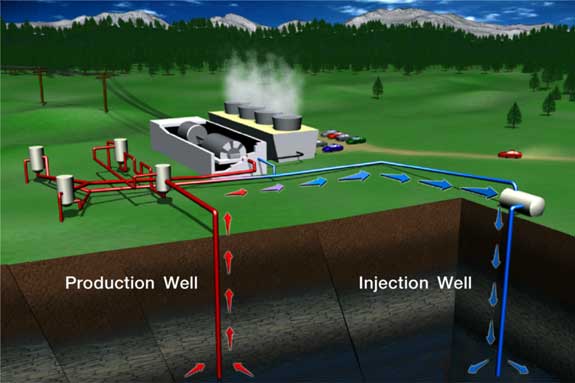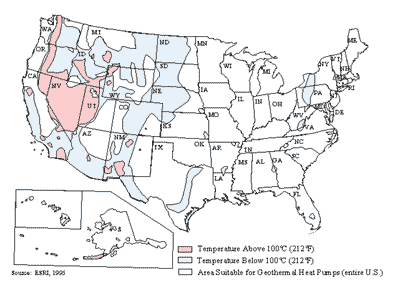Blog Archives
Hot dry rock or enhanced geothermal system?
Yesterday I had the pleasure to meet with a geologist who possesses vast knowledge of the geothermal landscape (literally.) One item that came up in our conversation was about the blog entry I wrote concerning geothermal power, and in particular “hot dry rock.”
The geologist indicated that HDR has been around for awhile with the initial work being pioneered in 1970 at the Fenton Hill site in Los Alamos, NM. Apparently the folks in Australia are at the same point the New Mexico crowd reached, they found hot dry rock, they were able to fracture it, but then the injection of fluids became something of an adventure. One doesn’t really know what will happen to the fluid injected into the system, sometimes it comes out the production wells and sometimes it doesn’t. No one really knows how to overcome that problem, though as the geologist noted, the Aussies seem very optimistic.
Enhanced geothermal systems (EGS) is the new HDR, at least here in the US. The idea behind EGS is to use similar approaches that the oil & gas folks use to “enhance” production by attempting to stimulate activity on the edges of a known resource with fluid injection. It has been demonstrated that geothermal systems can be stimulated simply by putting geothermal wells into production. There is a site in California where hot springs proximate to a production field were affected, not by drying up or cooling down, but by heating up!
It’s always valuable to chat with the experts, it’s very clear there’s a huge amount to learn in this area as well as huge opportunity.
Technorati Tags: Energy | Geothermal | Enhanced Geothermal Systems
Electricity from hot water
That’s right, geothermal resources (hot fluid and/or gas) can and is being used to generate electricity the world over. Geothermal literally means “heat from the earth.” The first successful geothermal electricity generation installation was in Larderello, Italy in 1904. The largest is the Geysers in Northern California where 21 plants generate around 3% of California’s electricity.
Geothermal resources can also be used for heating, cooling, and industrial pursuits by circulating the resource through chillers, heat exchangers, etc. This type of use mitigates the need to spend so much other energy in those processes and allows for the use of temperate (<75C) geothermal fluids. Beneath the crust of the earth is a large convection circulated body of magma. In weaker and thinner areas of the earth's crust (typically faults) heat from the magma in the mantle is transferred to rocks in the crust and then in turn to water in proximity to the rocks which creates the geothermal resources.

When generating power from geothermal resources, the resource needs to be rather hot >110C. There are 3 methods of tapping the resource: direct dry steam (rare,) direct flash steam (more common,) and binary (increasingly common.) Dry steam is used where the geothermal resources are extremely hot transforming the liquid in the geothermal well directly to gas which then is directed through a separation process to weed out non-steam (rocks, minerals) then routed into a turbine which generates power. The steam is then cooled back into liquid form and then typically reinjected into the geothermal field through an injection well.
Flash steam also requires a very hot resource, though cooler than dry steam, which follows the same process generally as dry steam with an extra step of routing the resource from the production well into a lower pressure area which allows the super-heated liquid to “flash” into steam (this may be repeated a series of times to gather the most steam possible at different pressures) before the resource is cooled and reinjected into the geothermal field.
Perhaps the most interesting and useful of the conversion technologies is the binary plant which uses a series of heat exchangers to transfer the geothermal fluid’s heat energy to a working fluid in a closed system. Typically, the working fluid has a boiling point that is less than that of water (~75C) which is then converted to steam and run through the turbine system, cooled, and recirculated through the system. In this way, the geothermal resource is never in direct contact with the turbine which extends the lifetime and reduces the maintenance associated with the system. The lower operating temperature makes a number of geothermal resources feasible that wouldn’t work with either dry or flash steam approaches.
NREL estimates that with current technology there is around 80GW of geothermal production potential in the US alone. Currently, 2.2GW is in production, primarily in California, Nevada, Utah, and Hawaii.

Another promising, though early development technology is called “hot dry rock” which is being pioneered in Australia. The theory here is to find an area of heat exchange in the crust that lacks water, boring into it, then injecting water to create a man-made geothermal resource.
Properly managed, geothermal is the most cost effective, least polluting, and most predictable of all the renewable energy sources. Disadvantages of the geothermal approach are primarily cost related, it costs around $2.5M/MW at scale to locate an appropriate site, establish the infrastructure, connect to the grid, and begin operations. But the advantages are truly amazing, virtually no emissions from the technology, 90% capacity factor, saleable by products from the dissolved solids (typically silica and zinc,) relatively small plants, and very predictable output. Areas like the Geysers have seen reduced production as the geothermal resource has been removed at a rate greater than natural (and later human assisted) replenishment. That’s where proper resource management comes into play.
Of all the renewable technologies, geothermal has the best chance to compete at scale with traditional fossil fuel plants on the basis of cost, predictability, and reliability.
Technorati Tags: Energy | Geothermal | Electricity
Biomass for the masses
A few months ago I posted an entry about biodiesel fuel which is a great example of biomass at work. A plant undergoing a process to transform it into a fuel for use (biorefining) in our current infrastructure, in this case, transportation.
That’s a great specific case, but biomass is, when you get right down to it, harnessing the power of photosynthesis. Biomass can be easily characterized as biofuels (biodiesel and ethanol,) biopower (typically burning plant waste to generate electricity,) and bioproducts (converting plants into chemicals that replace petroleum products.)
As is true with most renewable technologies, biomass has been around forever. While you might not really think of it this way, a wood fueled fire providing heat really is biomass at work.
Advantages to biomass include the fact that the fuel stock is renewable, plentiful, and generally neutral in CO2 emissions. We certainly know how to grow things very effectively. Disadvantages include particulate emissions from oxidation and farming related issues – water usage and pollution through fertilizers and insectacides. Also, each square meter of ground dedicated to biomass may be a square meter taken out of food production.
Garden variety soybean field (a prominant source of biofuels.)

Like wind and solar, biomass has it’s place in the renewable portfolio and has the potential, particularly in the transportation sector, to move us toward energy independence from fossil fuels.
Technorati Tags: Energy | Renewable | Biomass
$10.5B quarterly profit
Exxon reported $10.5B in profit for their most recent quarter of activity. Another quarterly report, another $10B profit, it’s good to be Exxon. That’s what they call in the business, real money…$1350 profit per second.
If just this quarter of Exxon’s profit was invested in renewable electricity generation using wind, it could fund approximately 10 GW of production leading to around 26 terawatt hours (TWh) (or 26,280,000,000,000 watt hours) of power and that could displace about 26 million kilotons of pollutants annually. This would require the investment of just ONE quarter’s profit.
The economic payback? About 13 years at current electric power prices ($30/MWh net of expenses.)
The lifetime profit? ~$11B.
The public relations and image value? Priceless.
Technorati Tags: Energy | Exxon | Profit
OPEC, cartel extraordinaire
If it wasn’t so sad, it would be funny that many countries with interests counter to the US are profiting immensely from our energy demands. Let’s face it, our appetite for energy in the US is insatiable. As a result, we can as a country be held hostage by those who have the resources necessary to supply our habit and those same people may engage in outright hostile activities toward the US with very little worry of reprisal (with the present situation in Iraq.)
What is the Organization of the Petroleum Exporting Countries (OPEC) anyway? According to the OPEC website it is:
OPEC is a permanent, intergovernmental organization consisting of 11 developing nations, whose economies rely on oil export revenues. One of OPEC’s primary missions is to achieve stable oil prices, which are fair and reasonable to consumers and producers.
If we view the dictionary.com definition of cartel, it states: an international syndicate, combine, or trust formed especially to regulate prices and output in some field of business. Let’s be plain about this, OPEC was founded to be a cartel, has the mission of a cartel, and is a cartel beholden to no one, but it’s 11 member states. Curiously, if the consumers of it’s product were smart enough and had sufficient will to respond to the cartel in an organized and consistent way, they could bring it down. (Other than demanding that the cartel produce more and not charge too much for that right…..which is what these consumers do now.) Why does this cartel have so much power? Because it controls 78% of the world’s proven petroleum reserves (897 billion barrels.)
Just who are the 11 OPEC member states?
- Algeria – Former French colony, now an unstable Arab state, 99% Sunni Muslim
- Indonesia – Former Dutch colony and Japanese possession, now a populous, predominantly Muslim (88%) state
- Iran – Formerly known as Persia, now a militant Islamic state suspected of supporting terrorism globally. Recently has asserted its right to join the nuclear nation club.
- Iraq – We’ve all heard enough about Iraq over the past 16 years.
- Kuwait – Former British colony, compartitively friendly post-liberation from Iraq, predominantly Muslim.
- Libya – Former Ottoman and Italian colony, recently reformed renouncing terrorism and weapons of mass destruction, predominantly Muslim.
- Nigeria – Former British colony, now an unstable African state, about 50% Muslim.
- Qatar – Former British protectorate, now a stable Arab state, predominantly Muslim.
- Saudi Arabia – A stable, Islamic monarchy. 100% Muslim.
- United Arab Emirates – Former British protectorate, progressive state by middle-eastern standards, predominantly Muslim.
- Venuzeula – Former Spanish colony and part of Gran Colombia, now stable socialist state, predominantly Catholic.
What do all these member states have in common? In general, they don’t care much for the US or our policies, but they’re happy to take our money to invest in our ultimate destruction. It’s rare to find such true irony.
By now you might be thinking “well this is depressing.” It is, but doesn’t have to be. With the technologies we have TODAY, we can make the decision to become independent of cartels simply by switching our focus and investment to renewable energy technology, both in electricity generation and in transportation. It can’t happen overnight, but it can happen within 20 years. BTW, what do you think you’ll be paying for a gallon of gasoline in 2026? I’ll bet you’re not saying $2.50…. A funny thing happens to unified producers when their largest, most dependent customer ceases to buy their product – they unravel from the inside out.
We have the ability to disentangle ourselves from this mess, shame on us if we don’t act upon it. The time to start is now.
Technorati Tags: Energy | Oil | OPEC









